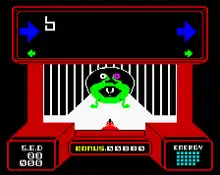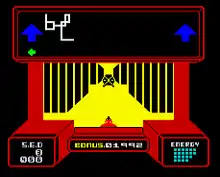Zig Zag (video game)
Zig Zag is a maze video game written by Ed Hickman and published by DK'Tronics in 1984. It was released for the ZX Spectrum[1] and the Commodore 64.[2]
| Zig Zag | |
|---|---|
 | |
| Developer(s) | DK'Tronics |
| Publisher(s) | DK'Tronics |
| Platform(s) | ZX Spectrum, C64 |
| Release | 1984 |
| Genre(s) | Action-adventure |
| Mode(s) | Single Player |
Gameplay
In Zig Zag, the player must explore a maze from first-person perspective searching for Scarabaqs. Scarabaqs are creatures that hold sector entry data that the player needs to continue to the next level. Scarabaqs flee from the player, who must exploit their behaviour to chase them into dead ends.
Adversity comes in the form of Hoverbots; their attacks drain the player's energy.
Zig Zag also supports the Currah MicroSpeech peripheral.
Development

The first-person 3D effect was achieved by using a series of vertical black lines to form the perspective of the walls, and to give the impression of the ceiling and floor. This also allowed relatively smooth movement animation, particularly when the player rotates left or right. However, some reviewers found the stripes to be an eye-strain.[3]
Reception
Reviewers were impressed with the 3D graphics and endearing nature of the Scarabaqs sprites and behaviour. The drawn-out chases were described as tiring, but addictive. CRASH magazine awarded 85% in issue 5.[3] In the CRASH issue 15 retrospective, Zig Zag was still appreciated as a good game although several reviews felt the gameplay became boring after a while.[4] Your Spectrum awarded an average of 5 out of 10 in issue 5, also highlighting the fast and colourful 3D effect but viewed it as a "common-or-garden maze game".[5]
References
- Zig Zag at World of Spectrum
- Zig Zag at Gamebase64
- Zig Zag review from CRASH issue 5, June 1985; retrieved from CRASH The Online Edition
- Crashback from CRASH issue 15, April 1985; retrieved from CRASH The Online Edition
- Zig Zag review from Your Spectrum issue 5, July 1984